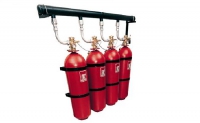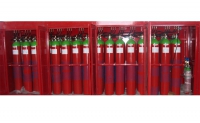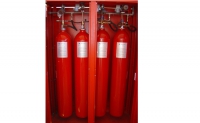
GASEOUS SYSTEM
Gaseous Fire Suppression System
These type of systems are effective and applicable for large range of fire classes (A, B, C) when other fire suppression systems (Water or foam) are not applicable due to limitation of use either causes to damage properties or human troubles.
The system typically consists of the agent, agent storage containers, agent release valves and hose, fire detectors, fire detection system (wiring control panel, actuation signaling), agent delivery piping, and agent dispersion nozzles.
These systems divide to following principal categories:
1- Co2 Fire Suppression system
2- Clean Agent Fire Suppression system
2.1- Inert gas fire suppression systems
2.2- Halocarbon fire suppression systems
There are four means used by the agents to extinguish a fire.
1- Reduction of heat (mostly Applicable by Co2 systems)
2- Reduction or isolation of oxygen (mostly Applicable by Co2 & Inert gas systems)
3- Inhibiting the chain reaction of the above components (mostly used by Halocarbon systems)
Application of Gaseous Fire Suppression systems:
There are two methods for applying an extinguishing agent:
- Total flooding
- Local application
Systems working on a total flooding principle apply an extinguishing agent to a three dimensional enclosed space in order to achieve a concentration of the agent (volume percent of the agent in air) adequate to extinguish the fire. These types of systems may be operated automatically by detection and related controls or manually by the operation of a system actuator.
Systems working on a local application principle apply an extinguishing agent directly onto a fire (usually a two dimensional area), or into the three dimensional region immediately surrounding the substance or object on fire. The main difference in local application from total flooding design is the absence of physical barriers enclosing the fire space.
Most used applications of these systems are as follows:
- Electrical facilities (Switchgear rooms, Battery rooms, Control rooms, security rooms, Metro halls.)
- Data center rooms
- Instrument rooms
- Antic galleries
- Museum
- Libraries
- Engine rooms
Certificates













